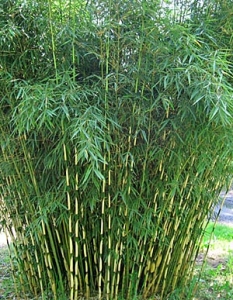Have No Fear Bamboo
-by George Graine, Fairfax County Master Gardener
“Between the bamboos tall the moonlight softly trickles, and I hear the cuckoos call.”
-Matsuo Basho, Japanese poet (1664-1694)
Let’s get something straight right away. Bamboo is not a plant to be feared. Bamboo is a misunderstood plant. Bamboo gets a bad rap from many people and some who ought to know better. The fact is, some people have selected the “wrong” type of bamboo or they did not understand how to contain this king of grasses, the fastest growing woody plant on earth. Some might say this is a plant gone wild and out of control, a reputation well deserved because many types of bamboo are aggressive and spread quickly. For others this may be just the ticket for a fast-growing privacy and textured screen. On the other hand, you can plant bamboo that does not run, and that is what this article is all about.

Fargesia robusta ‘Campbell’ A clumping bamboo that is hardy in zones 7-9.
In the past few years, bamboo propagators have introduced non-invasive, graceful ornamental clumping bamboos, which do not spread when planted. Look for plant tags that indicate sympodial, a clumping variety, whereas monopodial is a running type. Many clumping bamboo varieties are hardy to Zone 7a and 8, they offer a variety of form and texture, and they are available in variegated leaf and different cane colors. Depending on the type of “clumper,” they grow in either a tight or open clump.
Clumping bamboos have a limited root structure. The reason this type of bamboo rhizome does not have the ability to spread indiscriminately is because the growing tip turns upward and becomes a culm (cane); ergo, this is why it clumps and is considered to be non-invasive. As for the open-type clumping bamboo, this growth pattern happens because the rhizome necks on these species become elongated; therefore, the canes are spaced further apart. What you will actually see in clumpers is a dense mass of new canes that only increases a few inches in diameter each year unlike the running species. In either case, because of the way the rhizome grows, both these clumping varieties need not be contained with some type of barrier.
This type of bamboo typically grows 1-2 feet in height per year. The ultimate height is variable, depending on the species and climate. A healthy bamboo will often have a mixture of green leaves, yellow leaves, and new leaves that are unfurling. If the clump gets too large, it can be pruned back. (A whiskey barrel makes an ideal planter if you would rather not plant bamboo in your landscape.) Contrast this with running bamboos that spread by underground rhizomes and can cover great distances. These rhizomes are all connected to a single plant; it becomes extremely difficult to eliminate and thus becomes a vicious spreading pest.
Oh…one last point. Lucky Bamboo is actually a houseplant, Dracaena sanderiana – not related to bamboo which is a member of the grass family.